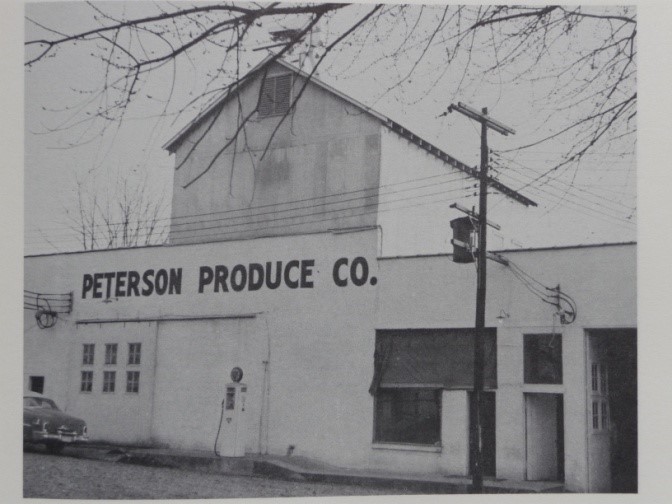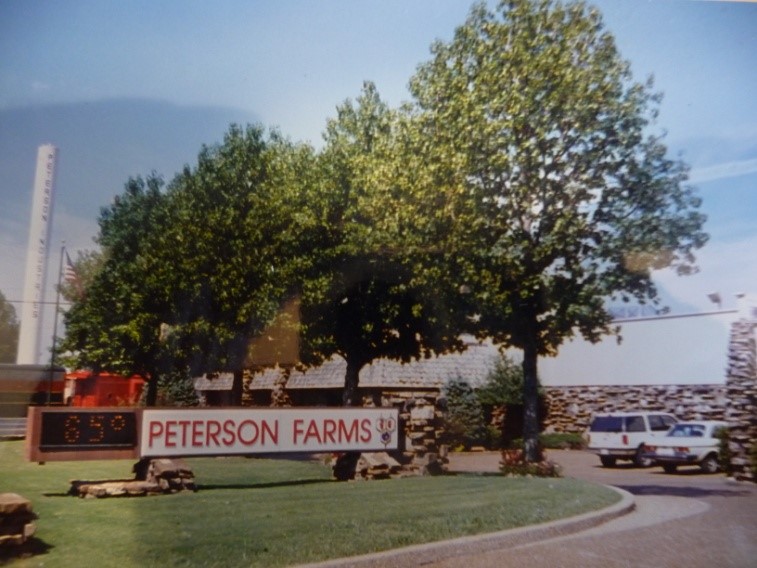Benjamin Peterson was a pioneer who in 1890, with his wife and son George Elmer, drove a wagon from Decatur, Illinois and acquired 160 acres of land in the north-western uplands of Arkansas near the town of Decatur. George and his brother Cal married the Beal sisters. George and Harriet had two sons, Raymond (1906) and Lloyd (1912). The family moved into Decatur so Lloyd could begin school in 1919. From the time he was in 5th Grade Lloyd never again asked his parents for money, earning cash by mowing lawns, digging ditches, milking cows and selling papers. The railway ran through Decatur and since it had a shipping shed, where other local towns with stations did not, Decatur became the shipping centre for the surrounding towns. Many farmers also became buyers and shipped farm produce both north and south on the Kansas City Southern. The town also had canning factories, a vinegar plant and a fruit drying plant. Lloyd Peterson was part of all the buying and selling farm produce. He was very good at baseball too and in 1932 he was offered contract from the New York Giants. He was also offered the job as manager of the local Farmers Union store; he decided on the latter. While managing the store Lloyd purchased 500 chicks and put them out to farmers on shares, chickens were placed in any empty sheds on farms or rooms in houses. Once it got established farmers were growing 250 at a time. Birds were grown to 3lb in about 16 weeks. The broiler industry in the County of Benton in which Decatur was located was started by J.J. Glover at Cave Springs and demonstrated that a living could be achieved growing chickens and selling them live to the markets in Chicago, Detroit or St Louis. The growers would travel with the chickens of the wagons feeding and watering en route. Lloyd Peterson developed his business by being fair and honest in all his dealing with his growers and feed suppliers. He gradually added pieces of an integrated industry and support for the growers and families in the district around the town.
In 1939 he started the Petersons Produce and Hatchery Company with a 12,000 egg capacity hatchery. He kept a large pool of breeds and his first product was a Barred Rock-New Hampshire Cross. Lloyd Peterson had no formal training in poultry production or genetics but his intense interest in being the best producer lead him to study the characteristics of the birds that performed well. He started out by providing farmers with 50 – 100 hens, sold them feed and bought back the hatching eggs. After hatching his growers produced the broilers and the live birds were sold to processors. In 1947 the company name was changed to Peterson Industries. Eventually the production system could no longer supply sufficient hatching eggs and in 1954 a breeding farm was established. He also built breeding farms on neighbours’ farms and contracted hatching egg production. In the late 40’s white birds were being the used in the breeding programme and Petersons was often called the home of the White Cornish Chicks. The merits of focussing on breeding a male saw the launching of the Peterson Male in 1954. The Peterson female soon followed. The success of the male breeding programme can be easily measured in the level of purchasing in the US. In the mid 1970’s Peterson had 70% of the market for male parents. Because of Mr. Peterson’s vision, Peterson Farms became a global enterprise, introducing the Peterson Male in more than 50 countries. Petersons established a processing and retail business Crystal Lake Foods and in 1994 dressed poultry were exported to Russia. Peterson Farms is the breeding and research arm of Peterson Industries and Peterson International Inc. operates the international business.
Everybody who knew Lloyd Peterson called him “Mr. Peterson.” It’s partly out of tradition but mostly out of respect –respect for a man who long ago had a vision of poultry breeding as the foundation of a company that could provide the world with a nutritious, low-cost source of meat protein.
In 1939, Mr. Peterson and Peterson Farms started out like all the others — buying breeders to produce chickens. But Mr. Peterson wasn’t happy with those breeders.
The people who worked with Mr. Peterson in the early days still talk about how he would spend hours in his poultry houses, studying his chickens, trying to figure a way to develop a faster-growing chicken — one that could be sent to market at a full weight but after a shorter growing period.
Mr. Peterson began keeping records on the chickens that grew faster and bigger. This, naturally, led him to the study of genetics. Soon, he had hired the brightest geneticists from around the world. The geneticists quickly discovered that Mr. Peterson — though he had never had any formal training — had acquired a deep knowledge of genetics and loved to pour over the data as the scientists crossbred various types of poultry.
Some genetic experiments would take years to complete, but Mr. Peterson was there every day, either in the chicken houses or in the laboratories, going over the results, asking questions, reading the textbooks and scholarly studies, challenging the accepted ideas about poultry breeding. That was how Mr. Peterson coined the Peterson Farms motto: “Balanced breeding for bottom line profits.”
Then, in the early 1950s, Peterson Farms introduced the “Peterson Male,” a bird that could survive better, grow faster, convert feed more efficiently, resist diseases, produce an attractive meat yield and breed effectively. The Peterson Male became the rooster known around the world.
Because of Mr. Peterson’s vision, Peterson Farms became a global enterprise, introducing the Peterson Male in more than 50 countries. The Peterson Female followed soon after. Scientists from around the world began coming to Peterson Farms to train in poultry breeding.
Because of that determination, Lloyd Peterson received what is probably the crowning recognition of his long career — being named to the 2001 American Poultry Hall of Fame. It is a fitting legacy for a man who has made a career of being both a realist and a visionary.


1951
Breeding research and development go into full swing
Scientists from around the world begin to come to Peterson Farms to participate in groundbreaking research.
1954-55
The “Peterson Male” is introduced.
1957
Breeding research and development operations are incorporated as Peterson Farms.
1958-59
The “Peterson Female” is introduced.
1959
Overseas sales and operations begin.
Decatur Foods, a chicken processor, goes into operations, later becoming Crystal Lake Foods processing division now carries the Peterson Farms brand.
Decatur Foods, a chicken processor, goes into operations, later becoming Crystal Lake Foods processing division now carries the Peterson Farms brand.
1970
Arkansas becomes the national leader in broiler production.
1977
Peterson Farms receives the U.S. Commerce Department “E” Excellence Award in a ceremony at the White House.
1989
Lloyd Peterson is inducted into the Arkansas Agriculture Hall of Fame.
Peterson Farms celebrates 50 years of achievement and service.
1990
Peterson Farms opens fifth hatchery in Decatur, Arkansas.
1994
Dressed poultry exports to Russia begin.
1998
Peterson Farms’ global expansion continues, with offices or sales in 50 countries around the world.
2001
Lloyd Peterson is inducted into the American Poultry Hall of Fame.

